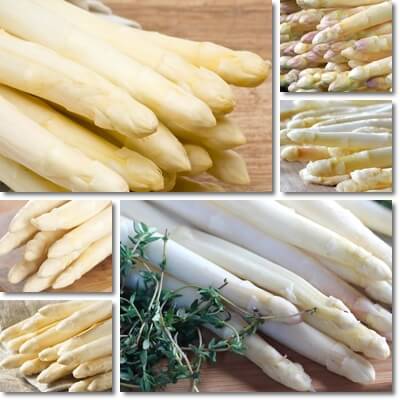White asparagus is the exact same vegetable as green and purple asparagus, except for the color, or lack thereof. The discolored variety is grown in the absence of sunlight which prevents pigment formation. While this results in a lower antioxidant content, it does not take away from its nutritional value. White asparagus is a good source of dietary fiber and protein and low in carbohydrates, fat and calories. It contains the amino acid asparagine and sulfur compounds that can make urine smell bad, which is the only side effect associated with reasonable intakes. B vitamins and a range of essential dietary minerals such as iron, potassium, sodium and zinc are a source of benefits for health.
What is white asparagus?
White asparagus is a white-colored variety of asparagus (part of the list white fruits and vegetables). Botanically speaking, it’s the exact same plant species as green and purple asparagus. The white color, or discoloration to be more exact, is a result of the absence of sunlight.
Asparagus plants are completely covered with earth as they grow and often also covered with a tarp – growing without sunlight prevents pigment from forming in the vegetable, resulting in discoloration, that is, white asparagus. If the tips manage to break through from the ground and receive sunlight, they slowly start developing pigment, usually a pink, purple-red or violet color.

What does white asparagus look like?
Overall, it looks a lot like green asparagus, just white. White asparagus spears are long, milky white on the outside and inside, and usually thicker than green asparagus. Discolored scale like leaves form along the stems, clustering at the top in a pointy, spear head-like tip (commonly called a flower head).
Compared to green varieties, white asparagus tend to be woodier, which is why it almost always requires peeling prior to cooking. Compared to green varieties, it is considered to be somewhat of a delicacy and often graded according to appearance.
How to choose white asparagus
- Grade 1: Younger, more tender spears that are perfectly straight, completely white, almost luminous-looking, and particularly thick are the highest-grade. The tips should form a tightly-closed tip, and the base of the stem should look moist, not dry – which is a sign of freshness.
- Grade 2: The second best white asparagus is milky white with pink, purple or violet tips, occasionally with a greenish-yellow tinge (color occurs as a result of exposure of the tips of the plant to sunlight). The stems may be straight or slightly curved, but the tips should be tight and the color almost luminous.
- Grade 3: Bruised, broken or visibly curved stems, stems looser tips and pregnant pigmentation are considered the lowest grade white asparagus. These typically have as much color as white discoloration or at least one third of the spear has color, with darker purplish pigment.
What does white asparagus taste like?
The taste and texture of white asparagus are heavily influenced by the time of harvest or age of the plant at the time of harvest as well as preparation, choice of cooking method and even cooking time. Typically, white asparagus has a milder taste than green asparagus and is pleasantly bitter, with light earthy flavor notes.
Overall, it tastes good, but quite different from green asparagus, given its mildness. However, plants belonging to certain cultivars can be particularly bitter. The tough outer peel is the main source of bitterness, so it needs to be removed prior to cooking the asparagus (for the best taste experience, remove generous amounts of the outer peel, starting right below the spear-shaped tips).
The bottom ends also tend to be woody – the older the plant, the woodier they are, so they are best discarded. You can remove them simply by snapping them off (you should feel the stems giving into pressure right where they’re supposed to). Grilling white asparagus can unearth faint sweet flavor notes. Boiling, steaming and roasting are the preferred cooking methods.

How to make white asparagus less bitter
It’s best to always choose fresh, locally-grown plants. Asparagus flavor fades with time so making sure it reaches your table as soon as possible helps you have the best taste experience. White asparagus is in full season from mid-April till late June, although it can be made available as early as mid-March (with prices to match).
The younger spears are more tender and also a lot less bitter. The outer peel and the woody lower ends are the main sources of bitterness, so discarding them should improve taste significantly. Don’t be afraid to peel as much as necessary.
Adding enough salt in the boiling water or even a little sugar or a few drops of lemon or lime juices should help temper the bitter taste. Generally, butter, cream, olive oil, mayonnaise, Hollandaise sauce, ham, boiled baby potatoes compliment the flavors of white asparagus beautifully.
White asparagus nutrition facts
There is little known about the nutrition of white asparagus. Even so, several key nutritional facts can be inferred from available scientific data on the nutritional profile of the standard variety, green asparagus. After all, they are the same vegetable, grown in the same soil and requiring about the same conditions overall, except for sunlight.
This being said, white asparagus is theorized to have about the same range of micro and macro-nutrients as green and purple varieties. That is, it contains modest amounts of dietary fiber (1-2 g per 100 g) and protein, including the amino acid asparagine, it is low in carbohydrates and sugar, and especially low in fat and calories (around 20 kcal per 100 g). It is a source of B vitamins, calcium, iron, magnesium, manganese, phosphorus, potassium, sodium and zinc.
Depending on soil quality, essential micro-nutrients such as copper, chromium and selenium may also be present in relevant amounts. However, white asparagus is considerably lower in antioxidants compared to green and purple varieties due to its almost complete lack of pigment. Plants that are completely white do not have any chlorophyll, carotenes or anthocyanins, but may contain other flavonoids with antioxidant properties. Also see the benefits of purple asparagus.
Does white asparagus have vitamin K?
It is possible the variety has some vitamin K, at least trace amounts of it. Typically, dark-colored leafy green vegetables are highest in vitamin K. For example, green asparagus provides over 40 micrograms of the vitamin for every 100 g. But some white vegetables also contain some vitamin K, such as cauliflower which provides 15.5 micrograms of vitamin K per 100 g or parsnip which has 22.5 micrograms.
To compare, the recommended intake is 120 micrograms of vitamin K a day for an average adult male and 90 for an adult woman. Other white foods such as turnips, onions or jicama have trace amounts of the vitamin, not enough to even be considered to be contributing to daily requirements. At this point, white asparagus can fall in any of these categories.
Does white asparagus have iron?
Despite the lack of information on its nutrition profile, white asparagus is believed to be a source of iron. The mineral iron is present in soil, although uptake by plants is determined by various factors such as soil pH, amount of rainfall and presence of other minerals. Iron is vital for the synthesis of chlorophyll and since white asparagus has the potential to synthesize chlorophyll (if allowed access to sunlight), it stands to reason it is capable of absorbing iron from the soil, at least in modest amounts.
Does white asparagus have zinc?
Yes, it does. Although the zinc status of soil differs from region to region, zinc is a mineral fairly present in soil and plants such as white asparagus should contain at least modest amounts of it.
White asparagus health benefits
- Good food to consider for healthy weight loss as it’s low in fat, carbohydrates and calories.
- Holds minor benefits for digestion and helps relieve constipation thanks to fiber content.
- Benefits for the brain and nervous system thanks to the amino acid asparagine.
- Source of antioxidants which free radical-scavenging and anti-inflammatory properties (antioxidant content is lowest than all varieties).
- Anticancer properties: animal studies show a methanolic extract of white asparagus activated apoptosis in colon cancer cells as well as reduced inflammatory markers.
- Source of essential nutrients such as B vitamins and dietary minerals with varied benefits: B vitamins and iron for energy metabolism, brain and nervous system function, skin health, dietary minerals with anti-inflammatory, antioxidant properties etc.
